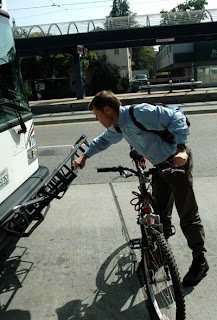 I decided to take my bike on a Valley Transportation Authority bus today, the first time I have taken advantage of this transit option. I was surprised at how simple it was to use the bike rack. As a member of the VTA board, I thought I’d see how the bike racks work.
I decided to take my bike on a Valley Transportation Authority bus today, the first time I have taken advantage of this transit option. I was surprised at how simple it was to use the bike rack. As a member of the VTA board, I thought I’d see how the bike racks work.I can see the advantage of knowing how to use the VTA bike racks, especially when planning longer bike trips. VTA buses and light rail trains run throughout Santa Clara County, with numerous connections to other transit systems, such as Caltrain, SamTrans, and Santa Cruz Metro.
I had always thought that using the rack on the front of the bus would take a long time, irritating my fellow passengers. But I was able to get my bicycle on and off the rack in a matter of seconds.
An important thing to remember when using the bike rack is to make eye contact with the driver so he or she knows that you will be loading your bicycle. This way the driver is not surprised to find you in front of the bus if he or she is distracted with other passengers boarding.
The bike is held on the rack with a spring-loaded hook, which pins the front tire down. This keeps the bike perfectly steady during the ride.
 Make sure to get off the bus using the front entrance, rather than the rear exit. My bus driver appreciated that I let him know that I would be retrieving my bike at the next stop so he didn’t pull away too early.
Make sure to get off the bus using the front entrance, rather than the rear exit. My bus driver appreciated that I let him know that I would be retrieving my bike at the next stop so he didn’t pull away too early.The rack has two slots for passengers’ bikes. If the rack is full, up to two bicyclists may bring their bikes on board if there is space.
VTA’s light rail trains also have bike racks to make commuting easier. These racks are inside the passenger cars, and a bicyclist lifts the bike into a vertical position to hang it from a hook.
